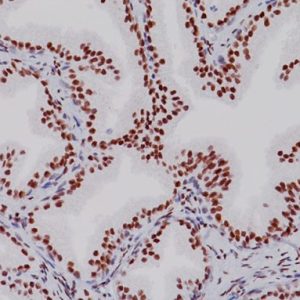Description
CDX2 is a homeobox gene that encodes an intestine-specific transcription factor and is expressed in the nuclei of epithelial cells of the intestine, from duodenum to rectum. The CDX2 protein is expressed in primary and metastatic colorectal carcinomas (1,2). It has also been identified in primary ovarian mucinous tumors and metastatic mucinous carcinomas involving the ovary (3). Studies have shown that the CDX2 marker is a more specific and sensitive marker when compared to CK20 (4). According to in-house studies, CDX2 [BC39] showed equal or superior sensitivity to clone CDX2-88, with virtually identical specificity.
SPECIFICATIONS
Specifications
| BY LETTER | C |
|---|---|
| CLONE | BC39, Biocare Clone |
| FORMAT | Concentrate, Predilute, UltraLine |
| INTENDED USE | IVD |
| ISOTYPE | IgG1/kappa |
| LOCALIZATION | Nuclear |
| POSITIVE CONTROL | Colon cancer |
| SPECIES REACTIVITY | Human; others not tested |
| VOLUME | 0.1 ml, 1.0 ml, 6.0 ml |
| SOURCE | Mouse Monoclonal |
REFERENCES
1. Werling RW, et al. CDX2, a highly sensitive and specific marker of adenocarcinomas of intestinal origin: an immunohistochemical survey of 476 primary and metastatic carcinomas. Am J Surg Pathol. 2003 Mar;27(3):303-10.
2. Barbareschi M, et al. CDX-2 homeobox gene expression is a reliable marker of colorectal adenocarcinoma metastases to the lungs. Am J Surg Pathol. 2003 Feb;27(2):141-9.
3. Bayrak R, et al. The value of CDX2 and cytokeratins 7 and 20 expression in differentiating colorectal adenocarcinomas from extraintestinal gastrointestinal adenocarcinomas: cytokeratin 7-/20+ phenotype is more specific than CDX2 antibody. Diagn Pathol. 2012 Jan 23;7:9.
4. Vang R, et al. Immunohistochemical expression of CDX2 in primary ovarian mucinous tumors and metastatic mucinous carcinomas involving the ovary: comparison with CK20 and correlation with coordinate expression of CK7. Mod Pathol. 2006 Nov;19(11):1421-8.
5. Center for Disease Control Manual. Guide: Safety Management, NO. CDC-22, Atlanta, GA. April 30, 1976 “Decontamination of Laboratory Sink Drains to Remove Azide Salts.”
6. Clinical and Laboratory Standards Institute (CLSI). Protection of Laboratory Workers from Occupationally Acquired Infections; Approved Guideline-Fourth Edition CLSI document M29-A4 Wayne, PA 2014.







Reviews
There are no reviews yet.